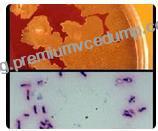NO.256 The clue to the identification of the colony seen in the upper frame is the gram stain in the lower frame, in which are seen short, rounded, gram positive bacilli, many of which possess distinct spores. As the colonies grew aerobically, the presence of spores indicates Bacillus species. The colonies are spreading, smooth, yellow-white and non-hemolytic. The lack of hemolysis and the small size of the bacterial cells suggests a species other than Bacillus cereus, the species causing most human infections. The isolate was identified as Bacillus circulans, which is consistent with the gram stain morphology. Clostridium septicum also produces spores; however, this species is an anaerobe and would grow poorly if at all and not produce spores aerobically. Listeria monocytogenes and Lactobacillus species are gram positive bacilli; however, neither of these produce spores.
The colonies seen in the upper frame, grown after 48 hours incubation aerobically at 35°C, and the accompanying gram stain in the lower frame are uncommonly associated with human disease, but have been associated with septicemia, bronchopneumonia, osteomyelitis and other infections, particularly in intravenous drug users. The most likely identification is:
